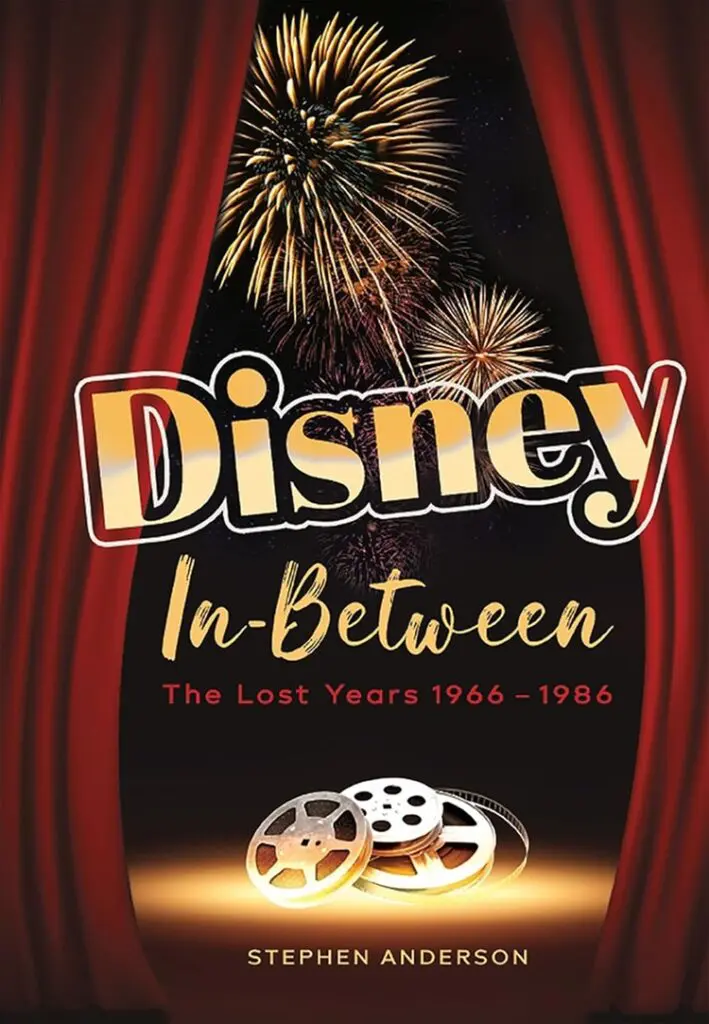
Sometimes, you have to fall before you can rise. That’s the premise floated by Stephen Anderson’s new book, Disney In-Between: The Lost Years 1966–1986. Over the course of 450+ pages, Anderson delves into the time when the Walt Disney Studio struggled to find its way after the sudden passing of its namesake.
Buy Disney In-Between: The Lost Years 1966–1986In December of 1966, Walt Disney died, and the studio he had created became rudderless. Walt was the one who made all the big creative decisions, and now with “the big cheese” not around to guide them, the plethora of immensely talented Disney artists didn’t know how to direct their energies. What would Disney be without Walt? In-fighting broke out, and the new leaders opted to favor the familiar and safe over leaning into exploring innovation and change as Walt himself had. The book quotes Card Walker, who served as the Disney Company’s top executive during this period, with this self-damning description of Disney’s ‘70s content: “We may bore you, but we will never shock you.”
The book mentions every movie the studio released during this period—most of which were flops—going into detail of the production of some, while merely presenting an anecdote about others. Anderson points out that while other studios were releasing movies that were riding the crest of changing tastes in storytelling, like Bonnie and Clyde and Easy Rider, Disney was sticking to familiar concepts it had succeeded with before—with diminishing returns. They tried to replicate the success of Mary Poppins with musicals The Happiest Millionaire and Bedknobs and Broomsticks, the latter about a magical woman who takes children on a series of adventures including entering a cel-animated world. The Computer Wore Tennis Shoes attempted to follow in the footsteps of Disney’s wacky science comedies like The Absent-Minded Professor and Son of Flubber, even setting the story at the same fictitious Medfield College featured in those films.
The book spends a lot of time focusing on the drama in Disney’s animation department during this period. From the old timers’ cold reception of early CalArts animators to the reasons behind Don Bluth leaving the studio and taking half of its animators with him, there is plenty here for animation historians to dig into. The differences between the working conditions on Mickey’s Christmas Carol and The Black Cauldron make for a particularly illuminating read, and explains why one of those productions is a beloved holiday classic while the other is largely considered viewing for Disney-completists only.
Author Anderson worked in Disney’s animation department, starting as a story artist on Tarzan. He would eventually go on to direct Meet the Robinsons and co-direct Disney’s 2011 Winnie the Pooh. You can tell he absorbed much of the information that went into this book from working with some of Disney’s older animators, particularly Burny Mattinson, who in 2018 became the company’s longest full-time employee. Anderson begins the book with Mattinson learning of Walt Disney’s death from animator Ollie Johnston, and weaves his story with the company throughout the book’s narrative, concluding the book with his passing in 2023 after celebrating 70 years at Disney.
While, as a Disney fan, I enjoyed the book, I was disappointed it focused solely on the studio’s output and ignored the company’s theme parks and how their development changed without Walt’s guidance. Other than a quick mention of The Main Street Electrical Parade’s Pete’s Dragon float and a short paragraph about Captain EO, the book says nothing about this whole side of the company. The year 1971 saw the opening of Walt Disney World, which was a massive undertaking, yet a photo of Angela Lansbury standing in front of a banner that reads “Walt Disney World, Florida” is the only mention it gets in the 1971 chapter. During this period, Walt Disney’s proposed “Experimental Prototype Community of Tomorrow” would go from being an ambitious city of the future to a World’s Fair-style theme park, and none of that is brought up.
I think the book should have been called something like “The Disney Studio In-Between” or “Disney’s Movies In-Between” to be more accurate. “But, Sombrero,” you yell at me from across the Internet. “Didn’t you see that the cover of the book clearly shows a bunch of film reels? Shouldn’t that have clued you into the book’s film focus?” “Ah, but then what of the fireworks?” I respond. “Aren’t those seeming to indicate the presence of content pertaining to the parks?” At this point, you become rather annoyed with me telling you what you are thinking and you wonder when I’m going to wrap this review up. Fear not, dear reader, and let us conclude now.
Disney In-Between: The Lost Years 1966–1986 is an in-depth look at the Disney Studio’s output during that turbulent 20-year period. It begins with studio staff learning they have lost their leader and ends with the ramp up to what has been dubbed “The Disney Renaissance.” It provides behind-the-scenes stories about the production of every Disney theatrical release during this period and the drama that didn’t make it onto the screen. It presents this with the narrative that all the missteps paved the way for Disney to become the entertainment powerhouse it was in the ‘90s. The book’s stories should delight Disney fans, as long as they know ahead of time about the book’s narrow focus.